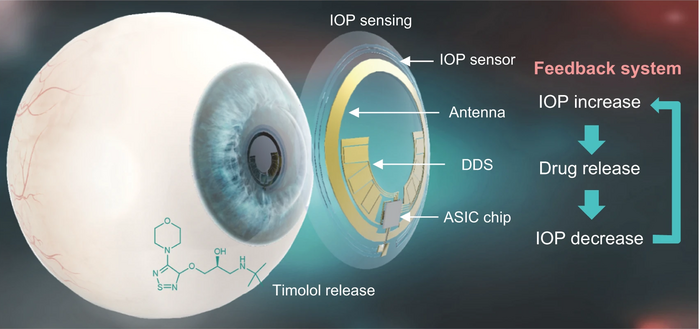Article
Smart contact lens that diagnoses and treats glaucoma
Author(s):
A POSTECH research team has developed a wireless theranostic smart contact lens for monitoring and control of intraocular pressure in glaucoma.
Schematic illustration of a theranostic smart contact lens for glaucoma treatment. (Image courtesy of POSTECH)

For ophthalmologists treating patients diagnosed with glaucoma, lifetime management of IOP levels is a given, and automatic monitoring and control of the IOP in these patients would significantly improve their quality of life.
Recently, a research team at Pohang University of Science and Technology (POSTECH) has developed a smart contact lens by combining an IOP sensor and a flexible drug delivery system to manage IOP measurement and medication administration.
A POSTECH research team led by Sei Kwang Hahn, PhD, and Tae Yeon Kim, PhD, (Department of Materials Science and Engineering) has developed a wireless theranostic smart contact lens for monitoring and control of intraocular pressure in glaucoma. Their findings were recently published in Nature Communications.1
The IOP sensors currently available for glaucoma patients do not have the function to administer the appropriate amount of drug in response to the IOP levels.
The smart contact lens developed by the research team has an IOP sensor that uses hollow nanowires made of gold. It is integrated with a flexible drug delivery system, wireless power and communication system, and an application-specific integrated circuit chip for both monitoring and control of IOP in glaucoma. Notably, the IOP sensor has exhibited high sensitivity to ocular strain, excellent chemical stability, and biocompatibility. Furthermore, the flexible drug delivery system can provide the on-demand delivery of timolol for IOP control.
The researchers successfully demonstrated that the theranostic smart contact lens enabled the IOP measurement in real-time and the appropriate amount of drug release to match the degree of IOP in rabbits with glaucoma.
The new smart contact lens is expected to make possible a personalized glaucoma treatment with maximum efficacy and minimal side effects. In addition, the feedback system would be applicable to various wearable devices other than smart contact lenses as well.
Professor Hahn who led this study commented, "We hope the early commercialization of the newly developed theranostic smart contact lens for diagnosing and treating glaucoma intraocular pressure to provide glaucoma patients’ compliance.”
This study was supported by the Basic Science Research Program, the Korea Medical Device Development Fund grant, BRIDGE Research Program, and Bio & Medical Technology Development Program of the National Research Foundation (NRF) funded by the Ministry of Science and ICT, Korea.
Reference
1. Sei Kwang Hahn, PhD, Tae Yeon Kim, PhD, Jee Won Mok, et.al. Wireless theranostic smart contact lens for monitoring and control of intraocular pressure in glaucoma. Nature Communications. Published November 2022. Accessed February 1, 2023. doi: 10.1038/s41467-022-34597-8
Newsletter
Don’t miss out—get Ophthalmology Times updates on the latest clinical advancements and expert interviews, straight to your inbox.




